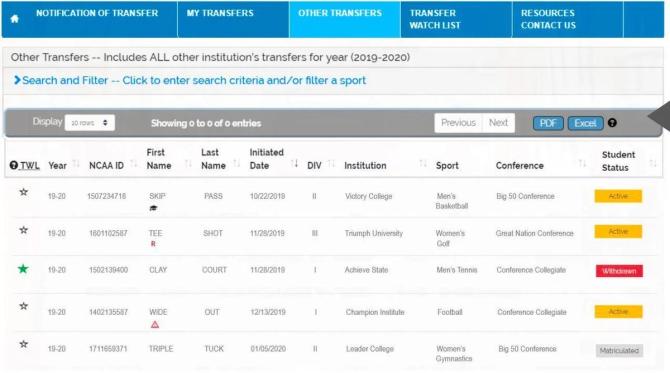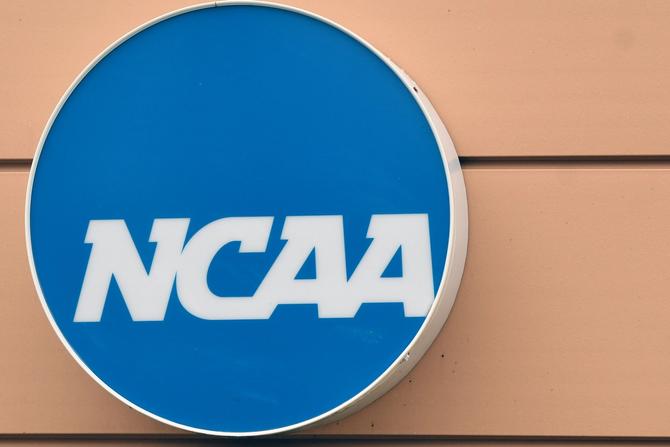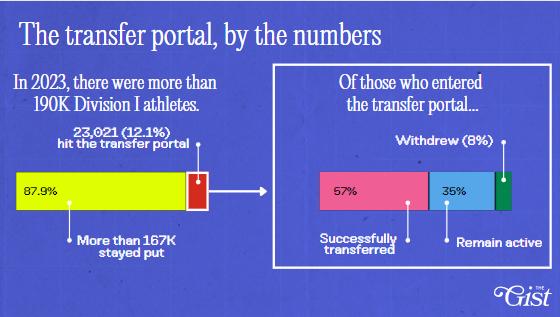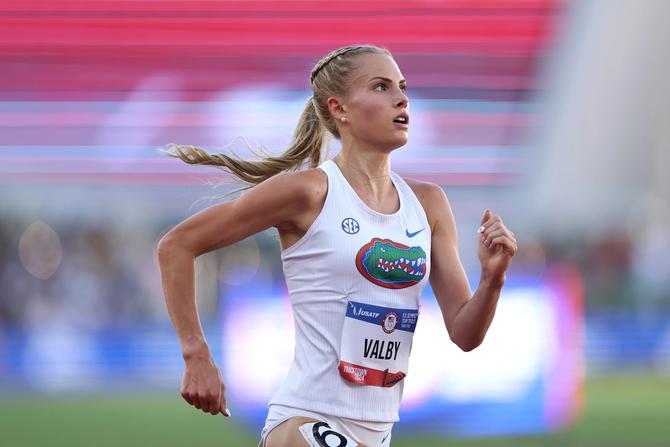More portal-jumping than a Marvel movie
From The GIST College Sports (hi@thegistsports.com)

Hi, friend!
Since a ton of GISTers told us they want to know more about the transfer portal, we’re dedicating today’s and Wednesday’s newsletters to this major force shaping college sports.
- Have more burning questions you want answered on Wednesday? Tell us here. The portal is bumpin’, but we’re sticking with you ’til the end.


— Former NCAA quarterback Jayden Daniels, one of the portal’s greatest beneficiaries, on his transfer from Arizona State to LSU for the 2023–24 season. In just one year with powerhouse LSU, Daniels won the Heisman (college football’s MVP) and became the No. 2 NFL Draft pick — not to mention an NIL millionaire. The grass really is greener sometimes.
How the transfer portal works
✏️ The history

Blockbuster transfers in college athletics aren’t new, but they used to be way less common. Pre-2018, athletes seeking to transfer had to jump through tons of complicated regulatory hoops, incentivizing them to stay put. Those in revenue-generating sports, like Division I (DI) football and basketball, also had to sit on the bench for a season before competing for their new squad.
- As a result, transfers typically occurred only in extreme circumstances, like head coaching changes or scholarship loss. But in 2018, the NCAA launched the transfer portal to significantly ease the process for all involved.
“The portal” sounds like something from a Marvel movie, but it’s actually a simple online database of all NCAA athletes interested in transferring. Players can simply notify their school’s compliance office of their intent to transfer, and they’ll be added to the portal within 48 hours — with way less paperwork and red tape.
- Coaches and administrators scour this database for new talent, à la pro leagues’ free agency — unless an athlete adds a “do not contact” tag to their profile, indicating they already know where they intend to play.
- This simplified process has given student-athletes control over their collegiate careers, ushering in a new era of athlete empowerment — but another massive change exploded the portal’s popularity…
In April 2021, the NCAA adopted legislation allowing first-time DI transfers to play without a mandatory year on the sidelines. Then in April, four months after a federal judge temporarily suspended the one-transfer limitation, the NCAA updated their guidelines accordingly to allow every athlete the ability to compete immediately, no matter how many times they’ve transferred.
- That freedom seemingly has everyone seeking a change of scenery, from the court to the gridiron to the mat to the diamond.
🚩 The rules

The transfer portal can feel lawless and chaotic, but the NCAA has been trying to regulate it ever since its 2018 launch — an effort that grew even more complicated when NIL hit the scene in 2021. Here are some of the portal’s guardrails.
🪟 Transfer windows: When it rains transfer announcements, it pours. That’s because athletes have a limited window after their seasons end to enter the portal. The NCAA is currently considering shrinking that time to 30 days for football and women’s and men’s basketball, but other sports’ windows range from 45 to 60 days, depending on their competition season.
- There are exceptions, of course: If a head coach departs or an athlete endures significant scholarship loss, players are allotted an additional 30-day window from the date of the change to enter the portal.
- These windows govern entry only — athletes can remain in the portal indefinitely until they find a new home. If they change their minds, they can withdraw and try to return to their old team…though their original squad can rescind their roster spot and/or scholarship as soon as they enter.
🤫 Impermissible contact and tampering: When coaches try to recruit other schools’ athletes before they hit the portal, it’s called impermissible contact, which is upgraded to a more serious violation called tampering if it results in a transfer.
- It’s a BFD, especially for smaller programs struggling to retain talent, but it’s notoriously difficult to enforce, and some larger programs blatantly flaunt the rules.
💸 Inducements: The NCAA prohibits schools from luring high school recruits or transfers with benefits like cash or gifts, aka inducements. That said, it’s all but impossible to control since a February preliminary injunction said the org can’t bar athletes from discussing business opportunities with prospective schools’ NIL collectives before enrolling.
- Elite athletes moving to bank more NIL money has become standard practice — and is perfectly legal, even though critics argue that the rise of NIL collectives has essentially created a pay-to-play scheme benefitting the wealthiest programs.
🔢 By the numbers

It feels like everyone is swapping schools these days…but what is the transfer portal’s true impact on college sports? Division I’s 2023 data provides some insight:
23,021: The number of DI student-athletes who entered the transfer portal in 2023. While it sounds like a lot, it’s only about 12% of the nation’s 190K DI athletes.
13,025: How many of those entrants actually ended up transferring (57%). The rest either remained with their original teams (8%) or are still listed as “active” in portal (35%) — meaning they’re still searching for a new school, have transferred to a non–NCAA program, or have stopped playing altogether.
1,420: The DI athletes who transferred from a program that didn’t offer them a scholarship to one that did, approximately 6.2% of all 2023 entrants. In contrast, 3,491 non-scholarship DI athletes (15.2%) in the portal remain active — meaning they’re still hoping someone will show them the money.
- Far more entrants (8,842, or 38.4%) successfully transferred from one scholarship opportunity to another, suggesting that the portal is perhaps better for chasing prestige, team culture, and NIL opportunities than for landing a scholarship.
32: The percentage of transferring DII athletes who leveled up to DI programs in 2023. Shifting down was far less common: Only 16% of the portal’s DI athletes chose a DII school, with a mere 3% switching to a DIII program.
Together With Nike

The college to pro pipeline was on full display at last week’s U.S. Olympic Track & Field Trials, with a stacked lineup of recent NCAAers competing for a spot at the Paris 2024 Olympic Games.
- And that includes Florida phenom and Nike athlete Parker Valby. After setting all kinds of records in her final collegiate season, she extended that hot streak into an impressive fourth place finish in the women’s 5000m and second place showing in the 10,000m.
Want to run like the elites? Mark your cal for this Wednesday’s release of Nike’s Blueprint Pack, which features the new and improved Pegasus 41 — tested and approved by The GIST’s very own.
Recs from our roster!
🏅 What to check out
This database of Team USA’s athletes, which will have you cheering on your local (!!!) Olympians in a few short weeks.
🎧 What to listen to
Calm Down With Erin Andrews and Charissa Thompson, the podcast that’s giving text chain. Erin and Charissa get real about life, gossip, sports, and more. Don’t miss this episode where they share their oh-so-sweet Eras Tour experience.
🎬 What to stream
Breaking Life: Road to Paris 2024. Before breaking makes its Olympic debut in Paris, learn about the lives of top breakers gearing up for the Games in this streaming series.
Today's email was brought to you by Katie Kehoe Foster and Briana Ekanem. Fact checking by Mikaela Perez. Ops by Lisa Minutillo and Elisha Gunaratnam. Ads by Katie Kehoe Foster and Alessandra Puccio. Managing edits by Dee Lab. Head of Content Ellen Hyslop.